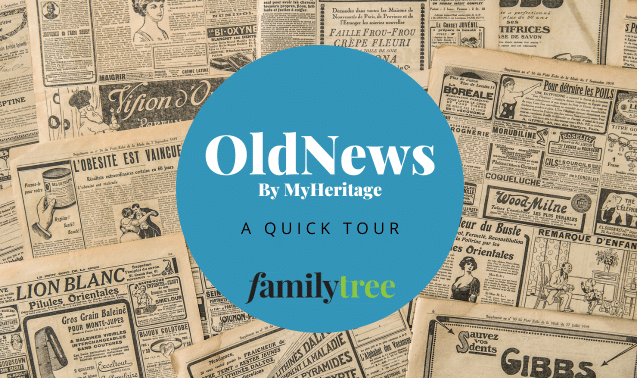Sign up for the Family Tree Newsletter! Plus, you’ll receive our 10 Essential Genealogy Research Forms PDF as a special thank you.
Get Your Free Genealogy Forms
"*" indicates required fields
Photos offer a quick glance into specific points in time—a beautiful wedding, a miraculous birth, an ordinary sunny afternoon—and immortalize them, allowing people to ponder over them for generations. Photos can also reveal a lot about how and when our ancestors lived. But what happens when you come across a photo and have to ask: who is this? Or what if you are just curious to see what visual history of your ancestors—if any—have accumulated over the years?
This is where DeadFred.com can help. Created by Joe Bott and maintained by him and volunteers, Dead Fred’s Genealogy Photo Archive—or simply Dead Fred or DeadFred.com—allows users to upload old photos of their ancestors and search for photos in numerous ways. Best of all, it is completely free. You don’t even have to register unless you wish to add photos or details to photos. Here are some tips to help you navigate this fascinating website.
1. Take Advantage of Many Distinct Search Functions
Exploring an online archive for the time can be an intimidating endeavor, especially if you are not sure how to phrase your searches to yield the best results. Fortunately, Dead Fred offers several different search functions that help you find the photos you are looking for.
Try the Detailed Search
The most sophisticated of Dead Fred’s search options is the Detailed Search, pictured below. You can access it by clicking the “Search Photos” link under Tools on the right.
The most notable thing about the Detailed Search is the amount of information you can search for. This information includes everything from first name, last name and maiden name to photographer state/province and photo type. Of course, you might not have all of those details at your disposal, and that’s okay as you can include as many or as few search terms as you would like or can provide.
For example, if you were looking for a Susanna Salter whom you know lived in Oklahoma but you lack much information beyond that, you can conduct your search using just those keywords.
You’ll see that the search yields one result: a Susanna Salter from Norman, OK. You can click on the photo for more details, which might help you determine if this the Susanna Salter you are looking for.
Sort Through Surnames
Perhaps all you know about the ancestor you are looking for is their last name. The good news is that DeadFred boasts almost 23,000 surnames in its Surname Search, and you can sort by letter to find the one you are looking for.
Be mindful of variations in spelling. For example, a glance under the S category reveals a Satterhwaite, a Satterthwaite and a Satterwhite. You might want to check them all just in case someone fumbled the spelling of your ancestor’s name.
Browse by Studio or Photographer
So, you stumble upon a photograph while thumbing through an old family album. An unfamiliar face stares back at you, cold and somber. You don’t have a name to attach to this stranger, not even a place, but the photo bears one name: the name of a mysterious studio. Could there be other unnamed photos just like this one out there?
You could try Dead Fred’s Photographer Search to find out. It contains almost 10,000 photographers and studios. Like the Surname Search, you can sort photographers alphabetically.
Delve into Mysteries
The structure of the Mysteries search option is similar to that of the Detailed Search in that you can make your searches as detailed or as succinct as you’d like. The key difference is that the photos that turn up in a Mysteries search will likely be missing some key details, most notably surnames. In fact, you will notice that this search form offers no surname field. Any images submitted without a surname will be filed under the Mysteries category.
The Mysteries search function is particularly handy if you simply wish to explore what photos are out there and if you have family out there looking to identify some particularly elusive ancestors. For example, maybe you know that your ancestors had largely settled in Cuyahoga County in Ohio but don’t have much information beyond that. You can search these terms exclusively.
As you can see, what comes up are several photos with nondescript titles like Bride & Groom, Wedding Couple and Young Family. All of them share a location: Cleveland.
While finding a long-lost relative via the Mysteries search function may not be likely, experimenting with it and seeing what photos are out there may help you better contextualize your own family history and answer questions you might have, such as: What did my ancestors’ hometown look like in years past? What did they wear?
2. Send a Photo
Let’s say that you look up the studio printed prominently on that old photo and your search yields no meaningful results. All hope may not be lost. The beauty of Dead Fred lies not just in potentially finding ancestors smiling in old, forgotten photographs but also in sharing your own photos for people to study, research and enjoy. You can send your photo by clicking the Post Photos link under Tools.
The easiest way to send a photo to Dead Fred is to simply upload it. Before you upload your photo, you will want to read the guidelines. One important point to keep in mind is that photos must have been taken no later than 1965 of subjects no longer alive. You also should make sure that your photo is in JPG format. Once your photo has been uploaded, you will be prompted to provide information about its subject so that people can find it more easily—first name, maiden name, surname, state or province and so on. Be sure to provide only one surname.
You can also physically send them your photo. You can reach out for instructions. However, do bear in mind that they cannot send your photo back to you. Dead Fred considers all photos donations.
3. Peruse School Yearbooks and Annuals
There is something nostalgic about leafing through old yearbooks, even if they are not your own. Like photos themselves, these mementos still time and gather special moments in one place. You can take a peek at some of these moments for yourself by browsing Dead Fred’s Annuals archive. You can explore numerous yearbooks from high schools, college and universities across the United States, ranging from the 1880s to the 1930s. While somewhat limited at the moment, this archive can help you better understand what school might have looked like for your ancestors.
4. Connect With a Lively Community
The value of Dead Fred extends beyond its quaint website. Dead Fred also maintains a clear presence across social media, particularly Facebook, where it boasts 220k followers. The Dead Fred Facebook page frequently features vintage photos and the histories that accompany them, both from the Dead Fred website and from around the internet. By staying connected, you can learn more about the rich history behind photographs, which can potentially strengthen your own family history research.
Old family photos can do more than just tell stories about the past; they can also connect people, inspiring conversation, the sparking of memories. Dead Fred encourages just this kind of collaboration.
Related Reads
Last updated: September 2024












